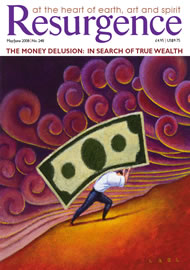THE ‘TRADITIONALISTS’ WHOSE writings are gathered together in The Underlying Religion stress that whilst there are many religious forms there is only one Truth or Principle. Imagine a mountain, they say, at the base of which are a number of gateways, each one opening onto a separate path that rises to the summit. Until one reaches the summit it is not possible to see that each of these paths leads to the same point. Indeed, it is likely that it is only when, in the state of enlightenment, one rises above the summit that one can see the twists and turns that each of the different paths may take before they finally converge. In seeking the summit, we must each choose and then follow a single traditional path even when, indeed especially when, the going gets tough.
The Underlying Religion must be read with this in mind. For here we find not what might be termed as the ‘liberal spirituality’ of much of contemporary debate, in which, often urged on by political correctness, one viewpoint is regarded as being as good as any other, but the much more defined and challenging viewpoint of the traditionalists.
Although this book is subtitled An Introduction to the Perennial Philosophy, it is made clear from the very start that whilst the traditionalist school of thought has been called ‘the perennial philosophy’, the preferred term is either ‘the perennial wisdom’ or, more especially, ‘the perennial religion’ – hence the title of the book. For whilst, according to the traditionalists, the root of philosophy is the love of wisdom, in the modern world it has come to mean something much meaner, something more akin to ‘rationalist or sceptical thought’; and the use of the term ‘perennial religion’ underlines the importance for the traditionalists of “the methodical and ritual practises that religion provides in order to effectively realise…wisdom”, so that whilst a philosophy may be thought out, a religious truth can only be known by being lived in the wholeness of one’s being.
This may seem uncomfortable – at least it may seem so here in the West and in a largely secular 21st century; and it is, therefore, no surprise that the opening section of this anthology should include a chapter that contrasts the traditional point of view with that which can be termed ‘modernist’ – the latter view being regarded as profane and flawed, since it disconnects us from that Principle which is timeless and sacred, reducing religion to no more than a series of moral and ethical propositions.
This often unnoticed conceptual shift – much more subtle than the obvious decline of religious practice itself – goes to the root of many of our contemporary dilemmas, not least the degradation of our relationship with Nature. For if there is nothing that is mysterious and beyond our humanity, nothing that is to be revered, we do, indeed, become masters of our own destiny, reliant upon no more than a profane worldliness and that which in these essays is referred to as “a sentimental humanism” where “nothing greater than man remains”.
Each of the essays in this important and timely book offers us a different and particular perspective upon ourselves and our relationships with each other, our environment and the cosmos. Collected together under themes that include metaphysics, science, symbolism and, indeed, the perennial philosophy itself, writers of the traditionalist school show us how “Truth, Prayer, Virtue, and Beauty are the heart of religion and thus ‘the religion of the heart’” – many treasures that delight, and many propositions that challenge!
One of the two essays by Ananda K. Coomaraswamy is of particular interest since it sheds light on the matter of the different pathways, a matter which goes to the heart of this book. Coomaraswamy invites us to give time to understanding the paths that others may take without that sense of ‘superiority’ that has sometimes been a characteristic of the Christian West. Indeed, he asks for something more than mere tolerance: something that will enable us to truly understand the similarities and differences of doctrine and practice so that the shared Truth, the Truth of Love, can be revealed. He underlines this with a wonderful quotation from Ibn al-‘Arab:
My heart is capable of every form:
it is a pasture for gazelles
and a convent for Christian
monks,
An idol-temple and the pilgrim’s
Ka’ba [Mecca]
and the tablets of the Torah and
the book of the Koran;
I follow the religion of Love,
whichever way his camels take;
my religion and my faith is
the true religion.
Using the image of the mountain and the many paths that lead to the one summit – the summit of the One – Coomaraswamy ends this essay with these lines:
Never let us approach another believer to ask him to become “one of us,” but approach him with respect as one who is already “one of His,” who is, and from whose invariable beauty all contingent being depends!
This, surely, emphasises the kinship of wisdom and compassion. This is The Way of Love, the understanding that Love is, which is to say that Love is the essence of being. And it therefore seems to me that if we wish to find the Truth we need to follow this path, for Love is both the pathway and that to which the path will lead us. It is the Quest and the Grail. It is the Underlying Religion.







